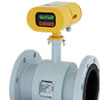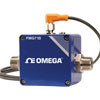Magnetic Flow Meter
Introduction to Magnetic Flow Meters
A magnetic flow meter (mag flow meter or magmeter) is a volumetric flow meter which does not have any moving parts and is ideal for wastewater
applications or any dirty liquid which is conductive or water based. Magnetic flow meters will generally not work with hydrocarbons,
distilled water and many non-aqueous solutions). Magmeters are also ideal for applications where low pressure drop and low maintenance are required.

Learn more about magnetic flow meters
Magnetic flow meter Selection
- Is the fluid conductive or water based?
- Is the fluid or slurry abrasive?
- Do you require an integral display or remote display?
- Do you require an analog output?
- What is the minimum and maximum flow rate for the flow meter?
- What is the minimum and maximum process pressure?
- What is the minimum and maximum process temperature?
- Is the fluid chemically compatible with the flow meter wetted parts?
- What is the size of the pipe?
- Is the pipe always full?
Electromagnetic flow meter principle
Faraday's Law The operation of a electromagnetic flowmeter is based upon Faraday's Law, which states that the voltage
induced across any conductor as it moves at right angles through a magnetic field is proportional to the velocity of that conductor.
Faraday's Formula
E is proportional to V x B x D where:
E = The voltage generated in a conductor
V = The velocity of the conductor
B = The magnetic field strength
D = The length of the conductor
To apply this principle to flow measurement with a magnetic flow meter, it is necessary first to state that the fluid being measured
must be electrically conductive for the Faraday principle to apply. As applied to the design of magnetic flowmeters, Faraday's Law indicates
that signal voltage (E) is dependent on the average liquid velocity (V) the magnetic field strength (B) and the length of the conductor (D)
(which in this instance is the distance between the electrodes).In the case of wafer-style magnetic flowmeters, a magnetic field is established
throughout the entire cross-section of the flow tube (Figure 1). If this magnetic field is considered as the measuring element of the magnetic
flowmeter, it can be seen that the measuring element is exposed to the hydraulic conditions throughout the entire cross-section of the flowmeter.
With insertion-style flowmeters, the magnetic field radiates outward from the inserted probe (Figure 2).
Choose the right magnetic flow meter
 In Line Magmeter
In Line Magmeter
These cost-effective magnetic flow meters combine superior noise immunity with high purity Alumina ceramic detection tubes, allowing precise flow measurements in a wide range of applications. These magmeters are available in pipe sizes from 1 /2 " up to 16" to accommodate many materials: chemicals, corrosives, foods, pulp and other solid matter slurry flows. The FMG-600 Series electromagnetic flow meter unique noise-suppression circuitry utilizes the optimum square-waved excitation frequency, eliminating various noises generated by slurries, making this flow meter ideal for pulp, food and grout applications.
 Insertion Style Magnetic Flow Meter
Insertion Style Magnetic Flow Meter
The FMG-550 Series fits pipe sizes from 2 to 48". The standard connection is a 1¼" NPT. It features an integral display for flow rate or totalization. The latest in bipolar pulsed dc technology and the best features of an insertion mag flow meter sensor are packed into the FMG-550 Series insertion magmeter. The FMG-551 is a electromagnetic flow meter to meet your flow measurements challenges.
Simple installation, easy maintenance, and state-of-the-art microprocessor technology make the FMG-551 the best alternative to traditional full-line magmeters.
The FMG-551 electromagnetic flow meter generates an isolated current output and an isolated frequency output.
The current output provides a universal signal to recorders, valves, and a host of process control and data acquisition devices.
 Insertion Style Magnetic Flow Meter
Insertion Style Magnetic Flow Meter
The FMG3000 and FMG3100 Series are for 0.5 to 8 in. Pipes. These are blind transmitter with either a 4 to 20mA or frequency output. All versions of this magmeter are constructed of corrosion-resistant materials to provide long-term reliability with minimal maintenance costs.
Frequently Asked Questions
Insertion Magmeters
Insertion type meters offered by Omega Engineering have a standard 2" NPT or fit into a specific size fitting. The FMG-550 Series are designed
for 2" to 48" in size with a flow rate of 0.05 to 10 m/sec (0.15 to 33 ft/sec). The FMG-550 Series offers an analog output with an integral
display for flow rate and totalization. The FMG3000 series offers corrosion resistant materials for pipes from 0.5 to 8". These insertion
type flowmeters are ideal for large pipe applications.
Minimum conductivity: 5 to 20 microSiemens/cm
Installation Considerations
Select a location for the sensor where the flow profile is fully developed and not affected by any disturbances.
A minimum of 10 pipe diameters of straight run upstream and 5 diameters downstream is recommended. Some situations may require 20 pipe diameters
or more upstream to insure a fully developed turbulent flow profile. The insertion magmeter is sensitive to air bubbles at the electrodes.
If there is any question that the pipe is absolutely full, mount the sensor at a 45 to 135 angle.
Grounding requirements
Magnetic flow sensors are sensitive to electrical noise which is present in most piping systems. In plastic piping systems,
the fluid carries significant levels of static electricity that must be grounded for best magmeter performance. Instructions are included with
the installation manual on how to best ground the magnetic flow meter.
In Line Magmeters
The in line type magnetic flow meters offer a higher accuracy. They can be as accurate as 0.5% of the flow rate. The insertion styles offer a
0.5 to 1% accuracy. Omega's FMG-600 series in line flange and wafer style meters offer higher flow rates of 1 to 10 m/sec. These in line meters
are offered in pipe sizes up to 12".
Minimum conductivity: 5 microSiemens/cm
Installation Considerations
In line flow meters do not require as much straight pipe as the insertion styles. A minimum of 5 to 10 pipe diameters
of straight run upstream and 1 to 2 diameters downstream is recommended. In vertical pipe runs, flow should always run up and not down. These
flowmeters are very sensitive to air bubbles. The magmeter cannot distinguish entrained air from the process fluid; therefore, air bubbles will
cause the magmeter to read high.
Low Flow Magmeters
These low flow mag flow meters are also in line and offer 3/8" to ½" NPT connections. The FMG200 series offer flow rates down to 0.38 LPM (.1 GPM).
A digital display with relay and analog outputs are standard.
For many years sensors used in high reliability applications, such as those used in aerospace and military applications, relied upon connectors
such as the Mil-C-5015 or MIL-C-38999 connectors that provided high reliability and secure connections but at a high price. With the
expanded use of industrial automation systems however, the number of sensors used have increased dramatically, driving the need for a
reliable, cost effective connection system for these sensors.
Magnetic Flow Meter | Related Products
↓ View this page in another language or region ↓
 CLOSE
CLOSE












 Medidores de Vazão Magnéticos
Medidores de Vazão Magnéticos Débitmètres Magnétiques
Débitmètres Magnétiques Caudalímetros Magnéticos
Caudalímetros Magnéticos Caudalímetros Magnéticos
Caudalímetros Magnéticos Magnetic Flow Meters
Magnetic Flow Meters Mågnetiske Flowmlere
Mågnetiske Flowmlere Débitmètre électromagnétique
Débitmètre électromagnétique Magnetisch-induktive Durchflussmesser
Magnetisch-induktive Durchflussmesser Flussimetri Elettromagnetici
Flussimetri Elettromagnetici Magnetic Flow Meters
Magnetic Flow Meters Caudalímetro electromagnético
Caudalímetro electromagnético Magnetic Flow Meters
Magnetic Flow Meters Magnetic Flow Meters
Magnetic Flow Meters Magnetic Flow Meters
Magnetic Flow Meters
 磁気流量計
磁気流量計 전자유량계
전자유량계 Magnetic Flow Meters
Magnetic Flow Meters
 Magnetic Flow Meters
Magnetic Flow Meters
 Magnetic Flow Meters
Magnetic Flow Meters
 Magnetic Flow Meters
Magnetic Flow Meters
 Magnetic Flow Meters
Magnetic Flow Meters